Fouga CM.170 Magister
| CM.170 Magister | |
|---|---|
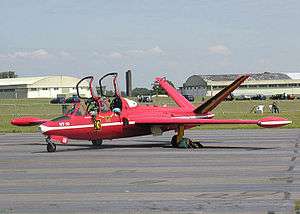 | |
| A Magister of the Belgian Air Force | |
| Role | Jet trainer |
| National origin | France |
| Manufacturer | Fouga |
| First flight | 23 July 1952 |
| Introduction | 1956 |
| Status | Retired; continues as civil-owned warbirds |
| Primary users | French Air Force Israeli Air Force German Air Force Finnish Air Force |
| Number built | 929 total Air Fouga: 576 Heinkel-Messerschmitt: 194 IAI: 36 Valmet: 62 |
| Unit cost |
$75000 |
| Variants | Fouga CM.175 Zéphyr |
The Fouga CM.170 Magister is a 1950s French two-seat jet trainer. The related CM.175 Zéphyr was a carrier-capable version for the French Navy.
Design and development


In 1948, Fouga designed a jet-powered primary trainer called CM.130 for the French Air Force (Armée de l'Air, AdA) to replace piston-engined Morane-Saulnier MS.475 aircraft. When AdA found the aircraft lacking in power from the two Turbomeca Palas turbojets, Fouga enlarged the basic design and used the more powerful Turbomeca Marboré engine. The distinctive V-tail of the new CM.170 Magister originated on the CM.8 (Castel-Mauboussin 8) glider Fouga was using to experiment with jet engines. In December 1950, AdA ordered three prototypes, with the first aircraft flying on 23 July 1952. A pre-production batch of 10 were ordered in June 1953 followed by the first production order for 95 aircraft on 13 January 1954.[1] Fouga built a new assembly plant at Toulouse-Blagnac to produce the aircraft. The aircraft entered service with AdA in 1956.
The Fouga Magister 170R was designed in 1949 by Robert Castello and Pierre Mauboussin. The first prototype flew on 23 July 1952 and the first one sold to AdA flew for the first time in February 1956.[2]
Due to industrial mergers, the aircraft has been known as the "Fouga CM.170 Magister", "Potez (Fouga) CM.170 Magister", Sud Aviation(Fouga) CM.170 Magister" and "Aérospatiale (Fouga) CM.170 Magister" depending on where and when they were built.
The French Navy's Aéronavale adopted a derivative of the Magister, the CM.175 Zéphyr, as a basic trainer for deck-landing training and carrier operations. These were preceded by two "proof of concept" prototypes designated the CM.170M Magister, which made their first flights in 1956/57.
An improved version of the Magister designated the CM.170-2 Magister was produced from 1960. It used a more powerful Turbomeca Marboré IV engine. Production of the Magister stopped in France in 1962 but it continued to be built in Finland up to 1967.
The development of the aircraft came to an end when the French Air Force selected the Alpha Jet as their new jet trainer.
After retirement, a number of Magisters were bought by private-owner pilots in the USA and are operated in the experimental category.
Operational history
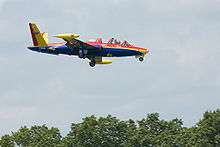
The first export customer was Germany who ordered 62 aircraft from Fouga, and Flugzeug Union Süd (a consortium of Heinkel and Messerschmitt[3]) license-built a further 188 aircraft.[1] In addition the CM.170 was built under license by Valmet in Finland, and Israel Aircraft Industries in Israel, with a total of 929 built. Of these 286 were completed under license.
Israel
The Israeli Air Force operated a license-manufactured version, the IAI Tzukit. While principally a trainer, it was used in the 1967 Six Day War by 147 Squadron as a close support aircraft, attacking targets on the Egyptian front during the first day of the war, when Israel's more capable combat aircraft were deployed on Operation Focus against Arab air bases.[4] They were then deployed against Jordanian forces, including armour, on the West Bank. The Magister proved effective at the close-support mission albeit with heavy casualties, with six being lost.[5]
El Salvador
9 former Israeli and 3 French Magisters were acquired by the Salvadoran Air Force and used as both trainers and ground attack aircraft in the Salvadoran Civil War using bombs and nose-mounted 7.62mm machine guns. None are recorded as being lost to enemy fire, but only five were in operational condition by the end of the war.[6]
Finland
In 1958-1959, Finland purchased 18 Fouga Magisters from France. At the same time they also obtained a manufacturing license. The Finnish aircraft manufacturer Valmet later built 62 Fouga aircraft between 1958–67. The French built aircraft carried the designations FM-1...-18 and the Finnish built FM-21...-82. The aircraft served as a jet trainer in the Finnish Air Force between 1958–1988 until superseded by BAe Hawks. A total of 21 Fouga Magisters were destroyed in accidents, six with fatal outcome. The usual Finnish Air Force nickname for the aircraft was Kukkopilli (Ocarina) because of the unique sound of the Turbomeca Marboré turbojet.
Belgium
The Belgian Air Force operated 50 Magisters as primary trainers. The aerobatic team The Red Devils also used them as display aircraft. A small number of Magisters remained in use until September 2007, as flight maintenance aircraft for senior officers. The Belgian Air Force was the last country that used Magisters for full duty.
Brazil
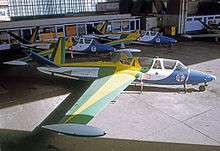
The Força Aérea Brasileira (FAB) used the Fouga Magister in their aerobatic display team, the Esquadrilha da Fumaça, from 1968 until 1975. Their aircraft were numbered T-24 in the trainer series of FAB type designations.
Katanga
During the Congo Crisis, the pro-secessionist Katangese Air Force (FAK) purchased nine newly built Magisters, set aside from a Belgian order. Only three were actually delivered to Katanga, in February 1961. One of these was used against the ONUC in the September 1961 Siege of Jadotville, flown by a Belgian and armed with two machine guns and two locally made light bombs. It destroyed two DC-4s and a DC-3 on the ground and made numerous attacks on ground targets. The aircraft was not used again after 1961.
Morocco
The Moroccan Air Force received 25 Magisters from France between 1956 and 1970, some of which were employed in the Western Sahara War against Polisario forces . The loss of several in action lead to the Magister's retirement from combat duties in the 1980s.[7]
Ireland
The Irish Air Corps operated six Fouga Magisters from 1975 to 1999, four of which equipped the Silver Swallows display team.
Variants


- CM.160
- A proposed lightweight version of the CM.170R for operation from grass or makeshift runways.[8]
- CM.170 Magister
- three prototypes and 10 pre-production aircraft.
- CM.170M Magister
- two prototypes for the French Aéronavale
- CM.170R
- Initial production version of the Magister.[8]
- CM.170-1 Magister
- first production version with Turbomeca Marboré II engines; 761 were built including 188 in West Germany, 62 in Finland and 50 in Israel.
- CM.170-2 Magister
- uprated Marboré VI engines with 4.7 kN (1,055 lbf) thrust each; 137 built.
- CM.171 Makalu
- enlarged airframe, Turbomeca Gabizo engines with 10.8 kN (2,422 lbf) thrust each, the only prototype lost in an accident on 20 March 1957
- CM.173 Super Magister/ Potez 94
- Marboré Super VI engines with 5.1 kN (1,143 lbf) thrust each and ejection seats; one prototype built.
- CM.175 Zéphyr
- A shipboard trainer for the Aéronavale, with strengthened undercarriage, catapult attachments and arrestor hook; 30 built.
- Potez CM.191
- 4-seat version of the Magister; two prototypes built.[9]
- IAI Tzukit
- or AMIT Fouga - Israeli Air Force version, updated with new cockpit, composite materials
- Fouga 90/90A
- Development based on the CM.170 with Turbomeca Astafan engines with 7.6 kN (1,715 lbf) thrust each, reshaped canopy for better visibility, and upgraded avionics. One prototype built. Proposed version 90A was equipped with a 790 kp Turbomeca Astafan engine; both versions failed to attract orders.
Operators
- Austrian Air Force (18 aircraft)
- Bangladeshi Air Force (eight ex-German aircraft)
- Belgian Air Component (50 aircraft, of which five are ex-German)
- Biafran Air Force (five aircraft)
- Brazilian Air Force (seven aircraft)
- Civilian CM-170M Magister registered as PT-ZIS
- Cambodian Air Force (four aircraft) and Khmer National Air Force
- Cameroon Air Force (nine ex-French aircraft)
- Air Force of El Salvador (nine ex-Israeli aircraft)
- Finnish Air Force (80 aircraft, 18 manufactured in France, 62 in Finland)
- French Air Force (397 aircraft)
- French Navy (32 aircraft)
- Gabonese Air Force (five ex-German aircraft)
- Luftwaffe (250 aircraft (62 new and 188 license production))
- German Navy (15 aircraft)
- Irish Air Corps (Seven CM170-2)

- Israeli Air Force (52 aircraft, 16 new and 36 license production, replaced by the Beechcraft T-6 Texan II)
- Lebanese Air Force (eight ex-German aircraft)
- Libyan Arab Air Force (12 ex-French aircraft)
- Royal Moroccan Air Force (21 new, ex-French and ex-German aircraft)
- Rwandan Air Force (three ex-French aircraft)
- Senegalese Air Force (five ex-Brazilian aircraft)
- Togolese Air Force (four ex-German aircraft)
- Ugandan Air Force (12 ex-Israel aircraft)
- United States Navy and United States Air Force: Civilian Contractor Owned/Operated ex-French aircraft are currently flown at the US Naval Test Pilot School and USAF Test Pilot School as training aircraft.
Specifications (CM.170-1)
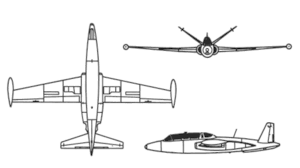
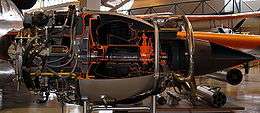

Data from Jane's All The World's Aircraft 1965–66[1]
General characteristics
- Crew: Two
- Length: 10.06 m (33 ft 0 in)
- Wingspan: 12.15 m (39 ft 10 in)
- Height: 2.80 m (9 ft 2 in)
- Wing area: 17.30 m² (186.1 ft²)
- Empty weight: 2,150 kg (4,740 lb)
- Loaded weight: 2,850 kg (6,280 lb)
- Max. takeoff weight: 3,200 kg (7,055 lb)
- Powerplant: 2 × Turbomeca Marboré IIA turbojets, 3.92 kN (880 lbf) each
Performance
- Maximum speed: 715 km/h (386 knots, 444 mph) at 9,000 m (30,000 ft)
- Range: 925 km (500 nmi, 575 mi)
- Service ceiling: 11,000 m (36,080 ft)
- Rate of climb: 17 m/s (3,345 ft/min)
- Wing loading: 165 kg/m² (34 lb/ft²)
- Thrust/weight: 0.28
Armament
- 2x 7.5 mm or 7.62 mm machine guns, 200 rounds/gun
- Up to 140 kg (310 lb) of weapons on two underwing hardpoints, including 50 kg (110 lb) bombs, unguided rockets, and Nord Aviation SS.11 anti-tank missiles.
See also
- Related development
- Aircraft of comparable role, configuration and era
- Aermacchi MB-326
- Aero L-29 Delfin
- BAC Jet Provost
- Canadair CT-114 Tutor
- Cessna T-37
- Fiat G.80
- Fokker S.14 Machtrainer
- Hispano HA-200
- Morane-Saulnier MS.755 Fleuret
- Morane-Saulnier MS-760
- PZL TS-11 Iskra
- Saab 105
- Soko G-2 Galeb
References
Notes
- 1 2 3 Taylor 1965, pp. 52–53.
- ↑ "Fouga CM 170." Pletav.free.fr. Retrieved: 18 November 2012.
- ↑ Taylor 1961, p. 81
- ↑ Aloni 2001, p.44.
- ↑ Aloni 2001, pp. 49–51, 54–55.
- ↑ Cooper, Tom. "El Salvador: 1980-1992". ACIG.org. Retrieved 30 January 2013.
- ↑ Cooper, Tom. "Morocco, Mauritania & West Sahara since 1972". ACIG.org. Retrieved 1 January 2016.
- 1 2 Bridgman, Leonard (1955). Jane's all the World's Aircraft 1955-56. London: Jane's all the World's Aircraft Publishing Co. Ltd.
- ↑ Flying Magazine, August 1961, p. 49.
- ↑ "Congo, Part 1; 1960-1963". ACIG. 2003. Retrieved 2013-08-09.
Bibliography
- Aloni, Shlomo. "Trainers in Combat:Valour and Sacrifice in the Six Day War". Air Enthusiast, No. 94, July/August 2001. Stamford, UK:Key Publishing. ISSN 0143-5450. pp. 42–55
- Arys, Marc and Serge van Heerthum. Fouga Magister: Whistling Turtles in Belgian Skies. Eindhoven, the Netherlands: Flash Aviation, 2007. ISBN 90-71553-24-8.
- Kopenhagen, W., ed. Das große Flugzeug-Typenbuch. Stuttgart, Germany: Transpress, 1987. ISBN 3-344-00162-0.
- Taylor, John W. R. Jane's All The World's Aircraft 1961–62. London: Sampson Low, Marston & Company, Ltd., 1961.
- Taylor, John W. R. Jane's All The World's Aircraft 1965–66. London:Sampson Low & Marston Company, 1965.
External links
| Wikimedia Commons has media related to Fouga Magister. |
- Newview official website
- Fouga Magister Jetwarbird Training
- History of the Fouga Magister
- Fouga CM-170 Magister
- Fouga Team Finland